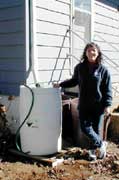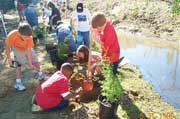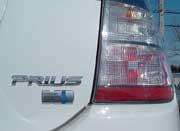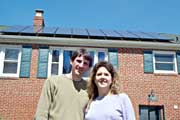|
|
 |
|||
|
Volume 13, Issue 16 ~ April 21-27, 2005
|
||||
|
It’s easy to be optimistic on Earth Day, with nature reasserting her vernal touch in the physical world around us and setting off a rebirth in our blood.
The state grant program that paid 10 percent of the Yuhas’ solar power plant “is meant to allow Marylanders to minimize their impact on the environment, right in their own backyards,” said Michael Richards, director of the Maryland Energy Administration. “Not only do the grants benefit individuals getting solar power, but these types of projects help the economy and create jobs.” Right now, over 500 people work in solar, plus about 25 consultants, said Peter Lowenthal, director of the MD-DC-VA Solar Energy Industries Association. “As an industry, we’re on a growth spurt,” he said. Aurora Energy LLC, the installer of the Yuhases’ solar panels is one of six solar companies in the Maryland, D.C. and Virginia area and is based in Annapolis. Seven other such solar companies in Maryland are part of the MD-DC-VA Solar Energy Industries Association. Solar panels used to be big clunky contraptions, but today’s panels are sleek and thin, blending in to the roof. A neighbor told Yuhas that his new panels linked the house to its solar history. Previous owners had a solar hot-water system, since removed by owners just before the Yuhases. Now the Yuhases are considering making solar-heated water their next investment. “The more people who use solar, the more it lowers the rates for everybody. It’s a win for energy, wind and water,” said Sen. Robert Garagiola, sponsor of the bill that created the grant program. A 20-foot by 20-foot panel area prevents a car’s worth of air pollution from entering the atmosphere each day.A solar system the size of the Yuhas’ will also prevent about three tons of carbon dioxide, 50 pounds of sulfur and about 20 pounds of nitrogen oxides from entering the environment each year, according to Aurora Energy. For the Yuhases, such a system means being good and happy children of Mother Earth. “People spend their hard-earned dollars on what makes them happy. It’s our way of adopting a good energy policy,” said Tom Yuhas. “We don’t have a big-screen TV or an SUV. This is what makes us happy.” —Carrie Steele Aurora Energy LLC: 410-268-3088 or Find a solar power system installer from the MD-DC-VA Solar Energy Industries Association: 301-530-5343.  ~ 3 Enlist Mother Nature to Help with Your Heating and Cooling ~ 3 Enlist Mother Nature to Help with Your Heating and CoolingThe trees that shade your house during the hot summer months are reducing your air-conditioning bill by as much as 20 percent. During the winter months, that tall dense evergreen hedge growing on the west side of your home is helping to reduce your winter heating bill by as much as 15 percent. Thus it pays to properly plan the landscape around your home. A well-planed landscape can not only save you money, but it can also make you money, adding to the value of your home. As trees and shrubs grow, their value increases. Their value to the planet is higher still. For maximum effectiveness, deciduous shade trees should be planted on the south and southwest side of the house. For aesthetics at least two trees should be planted no closer than 20 feet from the house and approximately 40 feet apart. They should be positioned so that they will cast a shadow over the roof of the house through most of the day. Deciduous species such as maples, oaks or London plane trees are best because they have well defined canopies to make shade in summer but drop their leaves to allow the sun to penetrate during the winter months. For planning that winter wind barrier, consider using tight-growing evergreen species such as arborvitae, Foster #2 holly, Sentinel Japanese holly or Hatfield yews where space is limited. For maximum effectiveness, plant a wind barrier within 30 feet of the foundation to extend beyond the width or length of the house. If space is not a limiting factor, then you might consider taller and larger growing species such as white pine, Norway spruce or evergreen southern magnolia. But you’ll have to plant these taller growing species farther away from your home to prevent them from shading the house during the winter months, when you want the sun’s heat, as well as less wind, to help you stay warm. —Francis R. Gouin  ~ 4 Reduce Your Impervious Surface ~ 4 Reduce Your Impervious SurfaceMaybe you don’t live on the waterfront. Maybe it takes you more than 20 minutes to see the Bay or one of its tributaries. But you can see the rain and you can watch it running off your roof, across your driveway and down your street. No matter where you live, you live in a watershed. Since you’re reading Bay Weekly, your watershed is likely Chesapeake Bay, and that’s where your runoff is heading. Runoff from your roof, your lawn, your driveway, your street, snakes its way to Bay waters carrying topsoil, car oil, dog poop, fertilizers, lawn chemicals and more. Home can be an enormous water collection system that funnels gallons to the Bay. Runoff and pollution come from the impervious surfaces around your home. An impervious surface, according to Maryland Department of Natural Resources, is “one composed of any material that significantly impedes or prevents natural infiltration of water into the soil.” All buildings and roofed structures, sidewalks, parking areas and any concrete, asphalt or compacted gravel surface are considered impervious. What can you do to help the rain to fall more gently on their piece of this earth? Landscape for Permeability: Plan a landscape design that is water friendly. Soils along the Chesapeake coastal plain are a mixture of sands and clay, often within feet of each other. If you have ever dug and encountered a heavy, solid orange or green soil you probably were digging a Chesapeake clay. You can persuade grass to grown over these areas, but heavy rains will hit the clay, bend the grass and drive a silt-laden water slide right into the Bay. You don’t need to eliminate your lawn, though. Take a look at walkways, driveways and patios. Is there a break between the hard surfaces and the lawn? Or do they allow water to flow unimpeded? An edging gap as small as one inch between a concrete patio and the lawn will help water to soak into the ground. Adding flower beds and natural areas with native plants increases rain absorbency even more. Thinking about paving a driveway or creating a barbecue patio? Instead of concrete or asphalt, consider open pavers that make room for moss and grass while making a firm surface for foot and vehicle traffic. Add mulch or stepping stones along foot paths. If you notice an area of heavy runoff, dig a pit one to two feet across and fill it with rocks (not fish gravel) — and plant ferns. These pits, spaces and beds form catchment areas where runoff is caught and held. As water sits in a puddle or gap, it soaks into the ground beneath. You’ll enjoy the added benefit of having a cool moist garden while a Maryland August bakes your neighbor’s plants. Take Control of Play Areas: Children and dogs can beat the ground bare in normal play. Use natural timbers to box in swings, play equipment and playhouses. Then fill the area with mulch. Your mulched playground will increase permeability and decrease injuries. If your dog has turned your backyard into a cratered moonscape, consider creating a special dog space. Dogs tend to maintain a roughly circular territory. Measure two feet from existing fences and install chicken wire fencing along the entire perimeter. This will make your pet a path to patrol while protecting landscaped areas within from erosion. If you have a doghouse, create a raised mulch bed under the house and move it to a rear corner of the yard. Run the fencing as above but allow two feet from the doghouse to provide room for your dog to loop around. Mulch added along the runways will reduce muddy feet as well as erosion. Go green: On the small lots of cities and old beach communities, your roof area may be greater in size than the land your homestead leaves exposed. Replacing hard roofs with a green roof can save money and the Bay. According to Maryland Department of the Environment, a green roof reduces runoff, filters out pollutants, reduces household heating and cooling bills and extends the life of the roof. Designs vary from an extensive roof, which tends to be self-maintaining, to intensive green roofs, which are tendable gardens on your rooftop. Extensive roofs are designed as shallow dish-style gardens with succulent plants such as Opuntia humifusa, a native Maryland cactus; Sedum ternatum, a native creeping sedum and Sempervivums, or hens and chickens. The Sempervivums were grown on rooftops in Europe because they were believed to protect the house from lighting strikes. Converting a standard asphalt roof to a green roof involves the application of several layers including a root repellent lining (keeps tree roots out of the attic) filter cloth (strains topsoil and dust from water), dirt and plants. Not every home is a candidate. Existing roofs must be certified by a structural engineer to sustain the additional load. Green roofs insulate buildings from cold in the winter and provide cooling in the summer when water evaporates from the rooftop plants. Get Your Mind in the Gutter: Check your gutter system. Installers may not have focused on erosion and runoff. Where possible, direct downspouts and gutters to drain onto the lawn, plant beds or containment areas where rain will soak into the soil rather than flow over the yard. Add a rain barrel. Try a soaker, a flexible hose with holes that unrolls and becomes a sprinkler when filled with water. Add it Up: One inch of rainfall across one acre of blacktop can send 26,000 gallons of fouled water into the Chesapeake Bay. Look around your home. Mentally add up the impervious areas of your roofing, walkways, driveway and any packed bare earth. To calculate how much rainwater runs off your property each year, first figure out your impervious square footage, then multiply that number by 623. Next, divide that product by 1,000, then multiply that result by the number of annual inches of rainfall in the your area. Annapolis is 41 inches per year. How much water does your home send to the Bay? Maybe this Earth Day is the day to reduce your impervious surface. —Kat Bennett  ~ 5 Use a Greener Cleaner ~ 5 Use a Greener CleanerLurking under kitchen sinks, stashed away in the cleaning closet and shelved in the garage are strings of syllables more often heard in a chemistry lab: ammonia (eye and lung irritant), hydrochloric acid, formaldehyde (suspected human carcinogens and strong irritants to the eyes), petroleum distillates (long-term exposure damages the nervous system, skin, kidneys and eyes), phenol (can cause kidney or liver damage) and perchloroethylene (suspected human carcinogen). As well as our drains, many of these chemicals get into our home’s air and within our bodies from residues on our hands and home surfaces. Many of these harmful household cleaners try to mask their harshness with dyes and fragrances, but a sweet-smelling toxin is still toxic. The U.S. Environmental Protection Agency has compiled a list of cleaners deemed safe for your health and the environment, if used correctly. If your cleaner is approved, you’ll find an EPA registration number on the back. You’ll find that to be both good and bad news when investigating your cabinets, however. The bad news is that many chemical cleaners — which include detergents, bathroom cleaners and polishes, among others — are bad for our health now and later. Even approved cleaners may have effects you don’t anticipate, such as irritating skin and eyes or causing other ill effects. Chemicals from cleaners also leach into the environment and our waterways. “Chlorine can form by-products that can be toxic to aquatic life,” said Beth McGee of the Chesapeake Bay Foundation. “Some cleaners also may contain surfactants to work better, but these can get into the horomone and reproductive systems of animals, and some of these compounds have been found downstream of water treatment plants.” The good news is that there are safer alternatives, and some work even better while costing less than their chemical counterparts. Without using toxins like chlorine, green cleaners use safer biodegradable ingredients, like citrus oils, that won’t harm the environment. Many of these solutions can be found on supermarket shelves alongside harsher cleaners. Earth-friendly stores like Whole Foods and Trader Joe’s sell only green cleaners. But most of what you need can be concocted in your own kitchen — saving you even more money. Streak-free glass cleaner can be made from white vinegar and water; newspaper works best to wipe the solution off of glass. Baking soda can scrub your tub, sink and counters clean. Baking soda followed by clear vinegar clears many drain clogs. Most homemade cleaners do not, however, disinfect. If you’re looking for disinfecting power, you’ll have to use bleach or isopropyl alcohol. “The main thing is that green cleaners don’t contain chlorine and are biodegradable,” said Marcy Damon of the Chesapeake Bay Foundation. “If a cleaning product has a large paragraph on the back, that’s a good indication of toxicity.” —Carrie Steele In celebration of Earth Day, Whole Foods in Annapolis will exchange your chemical cleaner or detergent for a safe green alternative cleaner. Fri., April 22, 8am-8pm @ Whole Foods Annapolis Harbour Center: 410-573-1800  ~ 6 Concentrate Your Political Clout ~ 6 Concentrate Your Political CloutLast year, state lawmakers in Annapolis agreed to charge a flush tax to help clean up the Bay. The bill was praised as “bi-partisan,” meaning that for once, Republicans and Democrats agreed on the law. As our elected leaders do not always work so productively for the Bay and environment, you may need to get involved in environmental lawmaking yourself by joining an environmental action group. Maryland League of Conservation Voters (www.mdlcv.org) has been lobbying as a nonpartisan organization to protect the environment for more than 25 years. The League’s message is similar to the message of other action groups including Chesapeake Bay Foundation (www.cbf.org) and 1000 Friends of Maryland (www.friendsofmd.org). Here’s how you can be one of the people who make a difference. Step One: Be informed. Nearly every action group has a Web site with loads of information about major issues affecting the Bay, including proposed and enacted legislation. By signing up for e-mail bulletins, you can gather more specific information about issues, policies and politics. Step Two: Stay in touch. Environmental organizations endorse the power of persuasion. You can enact change by writing an original letter to a local politician, sending a letter to the editor at Bay Weekly and other newspapers or e-mailing friends about local legislation. Step Three: Donate time, money or skills. Every environmental-action group seeks monetary donations or dues from its members. The donations help publish outreach material, maintain Web sites and cover other expenses. Some organizations also use your donations to fund clean-up efforts or projects, and League of Conservation Voters’ donations support lobbying. As well as donating money, you can donate time to join in projects, rallies or demonstrations. Participation in Bay-friendly events reminds politicians that there’s strength in numbers. Step Four: Keep score. State lawmakers are elected to represent their local constituents, so they need to hear your voice and know that you’re checking up on them. Keep track. If your legislators don’t support environmentally friendly legislation and turn a deaf ear to your persuasion, vote against them come election time. —Debra George Siedt  ~ 7 Reward Your Good Work with Energy Credits ~ 7 Reward Your Good Work with Energy CreditsVirtue is its own reward, but saving money makes virtue more rewarding. Several federal and state tax credits make it more appealing to trade in a gas-guzzling vehicle for an eco-friendly electric hybrid, more economical to install solar heating in a home or business or easier to reforest your land. Soaring gasoline prices aren’t the only reason to consider purchasing a hybrid car. For the next two years, the federal government will continue to offer a tax credit on approved alternative-fueled vehicles. Maryland consumers who purchase a Ford Escape Hybrid, a Honda Accord, Civic or Insight or a Toyota Prius are eligible for a $2,000 tax credit if the vehicle is in service by the end of 2005. A $500 state deduction can be claimed during 2006, but in 2007, Maryland eliminates the credit. Vehicles that completely depend on electricity are also eligible for a federal credit of 10 percent of the purchase price up to a maximum of $4,000. But in 2006, that credit is reduced by 75 percent to $1,000 before it is eliminated in 2007. “It’s a tough time to pass any tax credit or incentive,” said Brad Heavner, state director of MaryPrig, the Maryland Public Interest Research Group. “A lot of stuff is getting voted down because of tight budgets.” Still, Maryland offers two earth-smart incentives: for solar energy use and for green buildings. In 2004, Gov. Robert Ehrlich signed the solar energy grant program bill. The Maryland Energy Administration oversees the program, which has an annual budget of $103,500. You can seek grants to cover some of the costs of solar water-heating systems and residential or commercial solar-energy systems. Solar heating “fits in with an overall package,” said Tim LaRonde, program manager for the Maryland Energy Administration. “It should go in conjunction with other means of energy conservation.” Since the program started in January, 40 applications have come from solar energy pioneers eager to divvy up $76,000. May 15 is the application deadline for grants up to $2,000 toward the cost of a solar water-heating system or up to $3,000 and $5,000 for the cost of residential and nonresidential solar power systems. The program is planned to continue, although it requires legislative approval. “I would be surprised if they didn’t continue it,” LaRonde said. “But it is based on the [state] budget.” The Maryland Energy Administration also promotes Energy Star appliances, which conserve energy, even though state tax credits and exemptions for purchasing the products expired last year. The Maryland General Assembly passed the Maryland Clean Energy Incentive Act that went effect in 2000 under former Gov. Parris Glendening’s administration. Consumers were exempt from sales tax on purchases that included certain clothes washers, air conditioners and refrigerators. A subsequent bill to renew the tax credits did not pass the legislature. Even without the tax credit, “we’re heavily promoting Energy Star appliances,” LaRonde said. “It’s absolutely important for the Bay to reduce our consumption.” New businesses in Maryland can also do their part to keep the Earth healthy by building green. Green buildings use some 35 percent less energy than traditional buildings. “The technology is new and different,” said Michael Li, Energy Administration chief of staff. “Some studies have even quantified the increased productivity of employees.” But building green costs more, so such construction is eligible for a six- to eight-percent tax credit in Maryland. “The tax credit provides incentive for this type of building,” Li said. “The benefit is it helps lower the higher initial costs of building.” Three to seven years in, savings kick in. So, explains Li, “over the course of time, the return on investment is greater if you build green buildings.” Seven credits have been awarded since the program began in November 2003, two in Howard County, one in Prince George’s County, one in Baltimore County, two in Baltimore City and one in Montgomery County. Four more applications for commercial buildings are under review. The $25 million program will continue until 2011, when the General Assembly reassess it. Several other federal incentives for earth-friendly acts are available, although most are tailored for businesses rather than for individuals. A reforestation credit up to $10,000 subsidizes nurseries that grow trees for sale or for companies that produce timber products. The credit can be used to repay site preparation, seeds, labor and tools. Businesses, including poultry farms, that use wind for electricity are eligible for a credit based on the amount of energy used. —Debra George Siedt
|
||||
|
© COPYRIGHT 2004 by New Bay Enterprises, Inc. All rights reserved. |

 Holding Up This Good Earth
Holding Up This Good Earth ~ 1 Experiment with Alternative Fuels
~ 1 Experiment with Alternative Fuels
 Brick, gravel and natural stone
Brick, gravel and natural stone